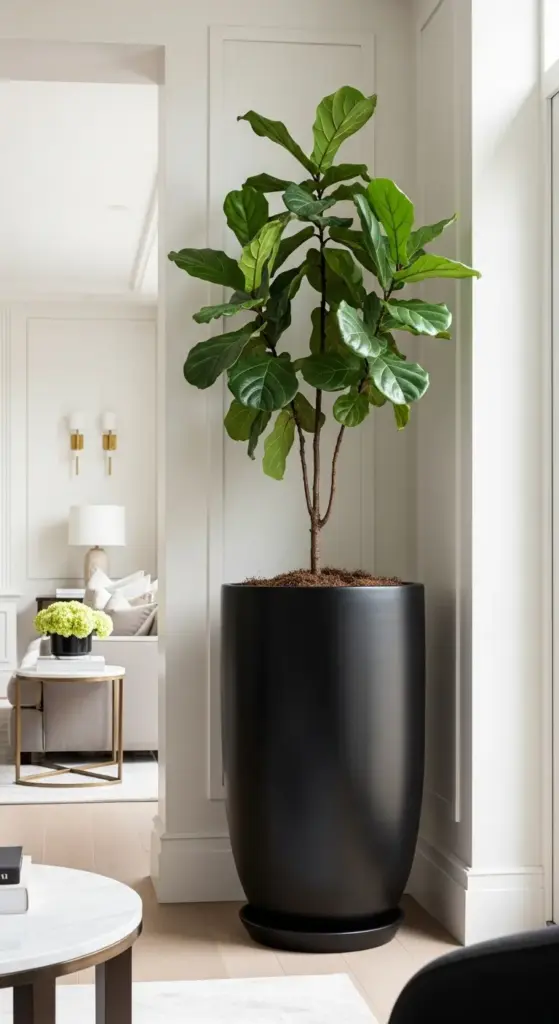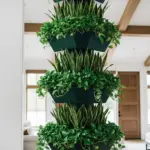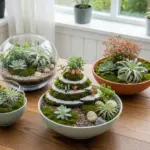6. The Statement Pot Investment Approach

I used to think buying expensive plant pots was just showing off. Why spend $80 on one pot when I could get eight $10 ones instead?
Then I saw what one gorgeous statement pot could do for an entire room.
My friend had this stunning large ceramic planter that made her fiddle leaf fig look like a piece of art. Everything else in her space suddenly looked more expensive too.
When to Splurge vs. Buy Multiple Cheap Pots
Here’s the math that changed my perspective: one $100 statement pot often has more visual impact than ten $10 pots scattered around.
Statement pots work best for your most prominent plant locations. Think entryway corners, living room focal points, or that empty spot everyone notices when they walk in.
I learned this after filling my apartment with cheap pots that looked fine individually but created visual chaos together.
The 80/20 investment rule works perfectly here. Spend 80% of your pot budget on one or two amazing pieces, then fill in with simpler, cheaper options.
Large plants (over 3 feet tall) deserve quality containers. A beautiful snake plant in a cheap plastic pot looks like you gave up halfway through decorating.
High-traffic areas benefit most from statement pots because they get seen constantly. Your bedroom corner plant can probably get away with a budget container.
The key is identifying which plants serve as room anchors versus which ones are just supporting players.
Choosing Statement Pots That Work Everywhere
This was tricky because I move apartments every few years. I needed versatile statement pots that would work with different decor styles and room layouts.
Neutral colors are your best investment. Black, white, cream, and natural terracotta work with virtually any color scheme or design style.
I chose a large matte black ceramic pot that’s worked in three different apartments with completely different aesthetics.
Classic shapes age better than trendy ones. Simple cylinders, clean rectangles, and organic curves never go out of style.
Timeless materials like ceramic, natural stone, or quality fiberglass look expensive and last forever. Avoid anything too shiny or obviously plastic.
Size flexibility matters too. Choose pots that can accommodate plant growth or different plant types over time.
I picked a 16-inch diameter pot that’s housed a fiddle leaf fig, a large monstera, and currently holds my bird of paradise.
The Investment Pot Checklist
After making some expensive mistakes, I created this quality assessment checklist that’s saved me from buyer’s remorse multiple times.
Drainage holes are non-negotiable. Beautiful pots without proper drainage will kill your plants and waste your investment.
Weight and stability matter for large pots. Lightweight containers tip over easily, while quality ceramic or stone provides natural stability.
Check the pot rim thickness – thin, delicate edges chip easily and look cheap after a few months.
Finish quality should feel smooth and even. Run your hands over the entire surface looking for rough spots or imperfections.
Color consistency throughout the pot indicates quality manufacturing. Blotchy or uneven coloring screams “budget production.”
Base design affects both stability and floor protection. Flat bottoms can scratch hardwood, while slightly raised bases allow air circulation.
Size proportions should look balanced. Pots that are too tall and narrow or too wide and shallow look awkward regardless of price.
Finding Designer-Quality Without Designer Prices
This is where I got smart about shopping. Designer-quality pots exist at reasonable prices if you know where to look.
End-of-season sales at garden centers offer 50-70% discounts on premium pots. I got my favorite $120 ceramic planter for $35 in November.
Restaurant supply stores carry commercial-grade planters that look expensive but cost way less than retail garden centers.
Facebook Marketplace and estate sales are goldmines for vintage and high-end pots at fraction of retail prices.
Wholesale pottery suppliers sometimes sell directly to consumers. I found a supplier who sells $200 pots for $60 if you buy directly from their warehouse.
Hotel and office building renovations often sell off their large planters. I scored two massive lobby-style pots for $50 each this way.
Ceramic studios and local artisans often charge less than big retailers for custom or one-off pieces.
Online wholesale sites like Alibaba have quality options if you’re willing to wait for shipping and buy in small quantities.
The trick is timing your purchases around sales cycles and being patient enough to wait for the right deal.
Quality inspection becomes crucial when buying discounted pots. Check for chips, cracks, or manufacturing defects before purchasing.
I keep a running list of pot styles I want and wait for sales rather than buying impulsively at full price.
The best statement pot investment is one that makes you smile every time you see it, regardless of what you paid.
Ready to learn the seasonal rotation system that keeps your plant displays looking fresh all year long? The next section reveals storage solutions for small apartments and the “plant pot wardrobe” approach that’s like having four different rooms – click below to discover the seasonal switching strategy!









GIPHY App Key not set. Please check settings